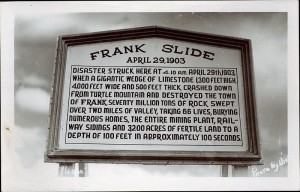Write a blog that hyper-links your research on the characters in GGRW according to the pages assigned to you (271-287). Be sure to make use of Jane Flick’s reference guide on your reading list.
In this section of the novel, there are many historical, literal and mythical allusions available for analysis. While conducting my research for this assignment, I was surprised at how many allusions are contained within this section of the novel, and it truly made me appreciate King’s narrative technique. Since I wrote on Dr. Hovaugh and Alberta Franklin in my previous blog, I focused on other allusions which required in-depth research in order to understand their significance within the context of the novel.
A. A. GABRIEL – When I first came across A. A. Gabriel I had no idea what his name could allude to. With the help of Jane Flick’s reference guide, I was able to establish a framework for my research around A. A. Gabriel’s character. His name alludes to religious figure Archangel Gabriel, who is considered as one of the messengers of God. King makes this allusion clear with the description on A. A. Gabriel’s business card which reads: “A. A. Gabriel, Heavenly Host” (270). He plays the role of God’s servant as he is the figure who informs Mary about her pregnancy with the son of God.
THOUGHT WOMAN – The role of the biblical Mary is played by the Thought Woman in King’s novel, and she is nothing like Mary. I believe King was influenced by Leslie Marmon Silko’s Ceremony in his creation of the Thought Woman. In Silko’s novel, the reader learns the importance about the Thought Woman to the First Nations culture, specifically within the Pueblo culture. The strength and interdependence shown by King’s character directly correlates with what the mythical definition of the Thought Woman. King’s character goes against the orders of conceiving a child which are given by A.A Gabriel. She finds the strength to go against God’s plan, much to the dismay of God’s messenger.
WHITE PAPER – The card that has A.A Gabriel’s information on it is also an allusion. The first time I read the passage I did not think much of it, but then when I re-read it, I noticed the description of the card as being “very white” (270). This set off alarms in my head because of the opposition of the colonizer vs the First Nations, and i researched this allusion. It turns out that the card represents the paper which Trudeau created that essentially ended the Indian Act in 1969. The refusal of the paper‘s contents by the First Nations people is celebrated by King with the Thought Woman, who embodies perseverance against white oppression.
LONE RANGER, HAWKEYE, ROBINSON CRUSOE – These names are allusions to fictional characters who are not of First Nations heritage. They allude to characters that have a big influence over the culture, as is in the context of this discussion. In the context I researched them within, they are involved in the cultural aspect of the First Nations people as they observe Ishmael and Coyote dancing. The aspect of colonization is present in these characters, especially Robinson Crusoe, as he criticizes the Coyote’s dance: “That’s not the right dance at all” (King 274). His name alludes to the Most Fabulous Hero in All Adventure History! Coyote’s character seems to resemble Friday’s character in terms of his interaction with King’s Robinson Crusoe. In Robinson Crusoe, Friday is depicted as the savage inhabitant of the land who must be properly taught by Robinson Crusoe. In King’s novel, I believe this relationship is brought to the forefront in this scene as Crusoe notifies Coyote that he is performing the wrong dance.
BABO JONES – Researching Babo’s character was the most enjoyable part of the assignment for me because I learned so much about her character that was previously unknown to me. I believe that Babo’s character is an allusion to the character in Benito Cerino, where Babo is an African slave who leads the rebellion upon a Spanish ship. King alludes to the racial oppression and inequalities with his version of Babo. He illustrates it in this scene when Babo is travelling with Dr. Hovaugh to find the missing Indians. Dr. Hovaugh thinks he is in control of Babo, but little does he know that it is Babo who is in control, as she played a major role in releasing the Indians from the hospital. King shows that not everything is what it seems on the surface with his portrayal of Babo.
BILL BURSUM – I read Lionel and Bill Bursum’s story as being interconnected, and how the white man during this time is showing his perceived dominance by not allowing the minority race to gain further equality. Even though Lionel is Bill’s best salesman, “he had never received a raise in all the years he had worked there” (King 277). I came to discover that Bill Bursum is an allusion to the Bursum Bill created by a senator named Holm O. Bursum in 1902, which essentially took land away from First Nations people and given back to the white people in New Mexico. Fortunately, an up rise was caused by the Pueblo tribe and the bill was defeated.
ELI STANDS ALONE – In the context of the passage in which Eli is talking to his family about finally being home, I think King’s character alludes to Elijah Harper, but in an opposite sense. Elijah Harper was the voice for Native rights as he stood up against the Meech Lake Accord and successfully won. In the sequence of pages I studied involving Eli, he is an outsider to his own culture, and does not have anything flattering to say about the reserves, as illustrated with his interaction with Norma: “The reserve’s not the world, Norma” (King 287). His reluctance to attend the Sun Dance with Karen shows that he is ashamed of his identity or lack of.
Works Cited
Davidson, E. Arnold. Border Crossings: Thomas King’s Cultural Inversions. Toronto: University of Toronto Press, 1993. Print.
Flick, Jane. “Reading Notes for Thomas King’s Green Grass, Running Water”. Canadian Literature 161/162. Autumn, 1999. Print.
King, Thomas. Green Grass, Running Water. Toronto: Harper Perennial, 1999. Print.
“Canton Asylum for Insane Indians.” Canton Asylum for Insane Indians. Web. 16 Mar. 2015. <http://cantonasylumforinsaneindians.com/history_blog/the-canton-asylum-for-insane- indians/the-bursum-bill>.
“Leslie Marmon Silko’s Ceremony and the Effects of White Contact on Pueblo Myth and Ritual.” Lislie Marmon Silko’s Ceremony. Web. 16 Mar. 2015. <http://history.hanover.edu/hhr/hhr93_2.html>.
“Synaxis of the Archangel Gabriel.” – Orthodox Church in America. Web. 16 Mar. 2015. <http://oca.org/saints/lives/2015/03/26/100886-synaxis-of-the-archangel-gabriel>.
“The White Paper 1969.” The White Paper 1969. Web. 16 Mar. 2015. <http://indigenousfoundations.arts.ubc.ca/home/government-policy/the-white-paper- 1969.html>.

